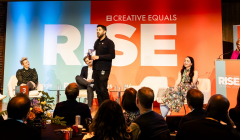
Are we leaving men and boys behind?
At Creative Equal’s RISE event, industry leaders consider how to reframe boys and men in marketing

Uplifting the female leaders in the industry can open doors for the leaders of tomorrow

The conversation about gender representation in the creative industry is a generational one, and women are still struggling to convince everyone that we are here to complete, not compete. We are, after all, 50% of the human workforce, not to mention 50% of the target audience for most products and services out there.
For years, the pendulum has been swinging with the zeitgeist; more recently, it’s gone from demand for diversity to survival of the fittest, thanks to a demanding pandemic where millions of women fell out of the workforce to support families. That’s when it became apparent that any progress that had been made was not (yet) completely sustainable.
The pendulum must swing the other way before it balances out, but by forcing it, we risk causing tokenism in the name of diversity, which is probably doing more long-term damage than we realise.
What we need is a systemic change with a lasting impact, not a reactionary one. This happens not only at the point of hiring, but when women are developed and supported across experience levels along their whole career path.
While over 60% of creative students are female, only 12% make it to director level. We are clearly losing them somewhere in between.
Rachna Dhall-Haasnoot, Co-Founder & Creative Director of Made in Amsterdam
As women, understandably, our path to the top is rarely the same as men. So seeing someone relatable climb the ladder can be exactly what girls and women need to see. What women want are role models that prove it can be done, no matter the odds – and to see other women as more than just tokens in the room.
Billy Jean King once famously said “You have to see it to be it”.
In a creative industry long dominated by men, this mantra can address the challenge of not just attracting the best young female talent, but keeping them inspired and interested too. When a girl sees other women thrive, she knows it’s possible to build a rewarding career of her own. While over 60% of creative students are female, only 12% make it to director level. We are clearly losing them somewhere in between.
This lack of female role models in the creative industry resonates with my personal experience. Growing up in India in the 90s, when the country had just opened its doors to economic liberation, my generation experienced global brands like Coke or Adidas for the first time. The world opened up to us, and like the rest of my contemporaries I wanted to get out there and see how far my talent would take me. But there was no template, coach or mentor at my first workplace (a global ad agency) back then. Looking back, I sometimes wonder what different choices I might have made had I been in closer proximity to strong female role models.
But where do we find these female role models to start this cycle of change? Or have they been right there all along?
Stop and look around you, and you will find these future role models. They are a part of your team or company, they’re your favourite client or a director or photographer you’re collaborating with. All it takes to lift these women up is to identify excellence without bias. Hire female talent based on merit, not gender. Reward them with challenges because of capability, not because the project needs ‘a feminine touch’. And support them through demanding life-stages like motherhood or menopause because you believe that it doesn’t change what they bring to the table. Do it for your interns and for your C-suite in equal measure.
Build a culture based on merit, not tokenism, and let it take its course. Who knows, we might end up with an industry that represents society as it is.
Rachna Dhall-Haasnoot is co-founder & creative director of Made in Amsterdam (a part of The Breathe Network) who has beef with rampant tokenism in the creative industry.
Looks like you need to create a Creativebrief account to perform this action.
Create account Sign inLooks like you need to create a Creativebrief account to perform this action.
Create account Sign in